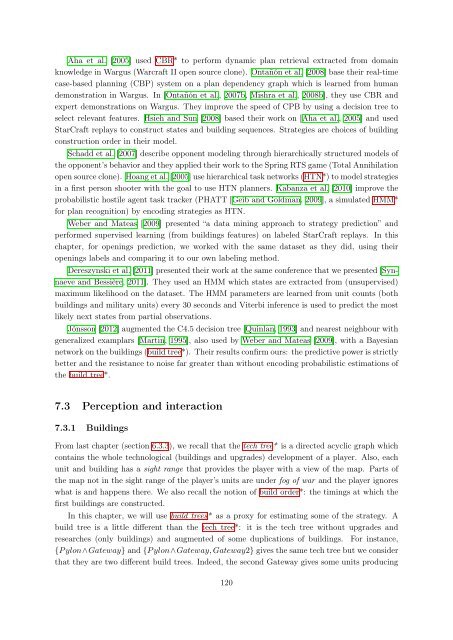Bayesian Programming and Learning for Multi-Player Video Games ...
Bayesian Programming and Learning for Multi-Player Video Games ...
Bayesian Programming and Learning for Multi-Player Video Games ...
Create successful ePaper yourself
Turn your PDF publications into a flip-book with our unique Google optimized e-Paper software.
Aha et al. [2005] used CBR* to per<strong>for</strong>m dynamic plan retrieval extracted from domain<br />
knowledge in Wargus (Warcraft II open source clone). Ontañón et al. [2008] base their real-time<br />
case-based planning (CBP) system on a plan dependency graph which is learned from human<br />
demonstration in Wargus. In [Ontañón et al., 2007b, Mishra et al., 2008b], they use CBR <strong>and</strong><br />
expert demonstrations on Wargus. They improve the speed of CPB by using a decision tree to<br />
select relevant features. Hsieh <strong>and</strong> Sun [2008] based their work on [Aha et al., 2005] <strong>and</strong> used<br />
StarCraft replays to construct states <strong>and</strong> building sequences. Strategies are choices of building<br />
construction order in their model.<br />
Schadd et al. [2007] describe opponent modeling through hierarchically structured models of<br />
the opponent’s behavior <strong>and</strong> they applied their work to the Spring RTS game (Total Annihilation<br />
open source clone). Hoang et al. [2005] use hierarchical task networks (HTN*) to model strategies<br />
in a first person shooter with the goal to use HTN planners. Kabanza et al. [2010] improve the<br />
probabilistic hostile agent task tracker (PHATT [Geib <strong>and</strong> Goldman, 2009], a simulated HMM*<br />
<strong>for</strong> plan recognition) by encoding strategies as HTN.<br />
Weber <strong>and</strong> Mateas [2009] presented “a data mining approach to strategy prediction” <strong>and</strong><br />
per<strong>for</strong>med supervised learning (from buildings features) on labeled StarCraft replays. In this<br />
chapter, <strong>for</strong> openings prediction, we worked with the same dataset as they did, using their<br />
openings labels <strong>and</strong> comparing it to our own labeling method.<br />
Dereszynski et al. [2011] presented their work at the same conference that we presented [Synnaeve<br />
<strong>and</strong> Bessière, 2011]. They used an HMM which states are extracted from (unsupervised)<br />
maximum likelihood on the dataset. The HMM parameters are learned from unit counts (both<br />
buildings <strong>and</strong> military units) every 30 seconds <strong>and</strong> Viterbi inference is used to predict the most<br />
likely next states from partial observations.<br />
Jónsson [2012] augmented the C4.5 decision tree [Quinlan, 1993] <strong>and</strong> nearest neighbour with<br />
generalized examplars [Martin, 1995], also used by Weber <strong>and</strong> Mateas [2009], with a <strong>Bayesian</strong><br />
network on the buildings (build tree*). Their results confirm ours: the predictive power is strictly<br />
better <strong>and</strong> the resistance to noise far greater than without encoding probabilistic estimations of<br />
the build tree*.<br />
7.3 Perception <strong>and</strong> interaction<br />
7.3.1 Buildings<br />
From last chapter (section 6.3.3), we recall that the tech tree* is a directed acyclic graph which<br />
contains the whole technological (buildings <strong>and</strong> upgrades) development of a player. Also, each<br />
unit <strong>and</strong> building has a sight range that provides the player with a view of the map. Parts of<br />
the map not in the sight range of the player’s units are under fog of war <strong>and</strong> the player ignores<br />
what is <strong>and</strong> happens there. We also recall the notion of build order*: the timings at which the<br />
first buildings are constructed.<br />
In this chapter, we will use build trees* as a proxy <strong>for</strong> estimating some of the strategy. A<br />
build tree is a little different than the tech tree*: it is the tech tree without upgrades <strong>and</strong><br />
researches (only buildings) <strong>and</strong> augmented of some duplications of buildings. For instance,<br />
{P ylon∧Gateway} <strong>and</strong> {P ylon∧Gateway, Gateway2} gives the same tech tree but we consider<br />
that they are two different build trees. Indeed, the second Gateway gives some units producing<br />
120


